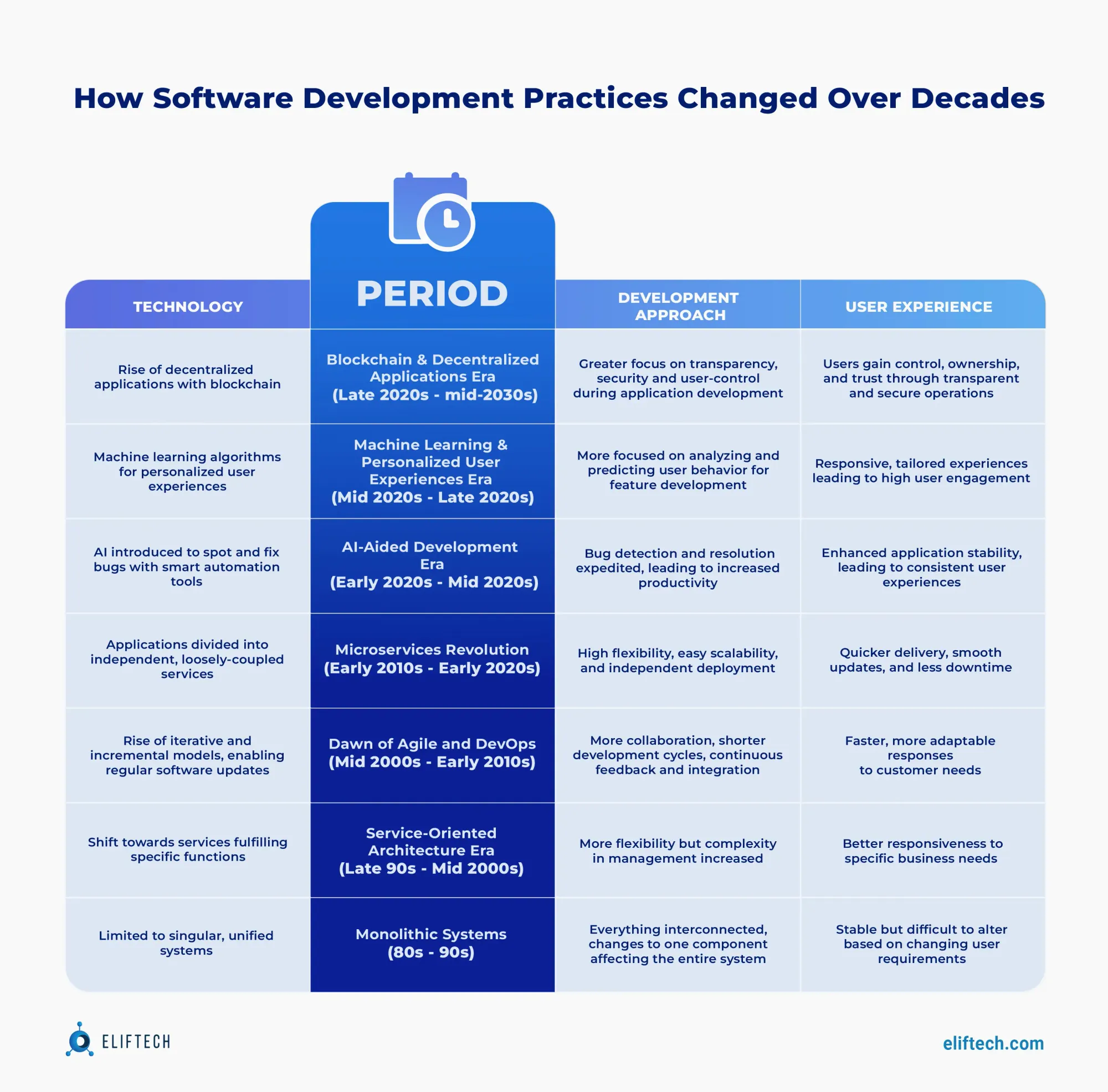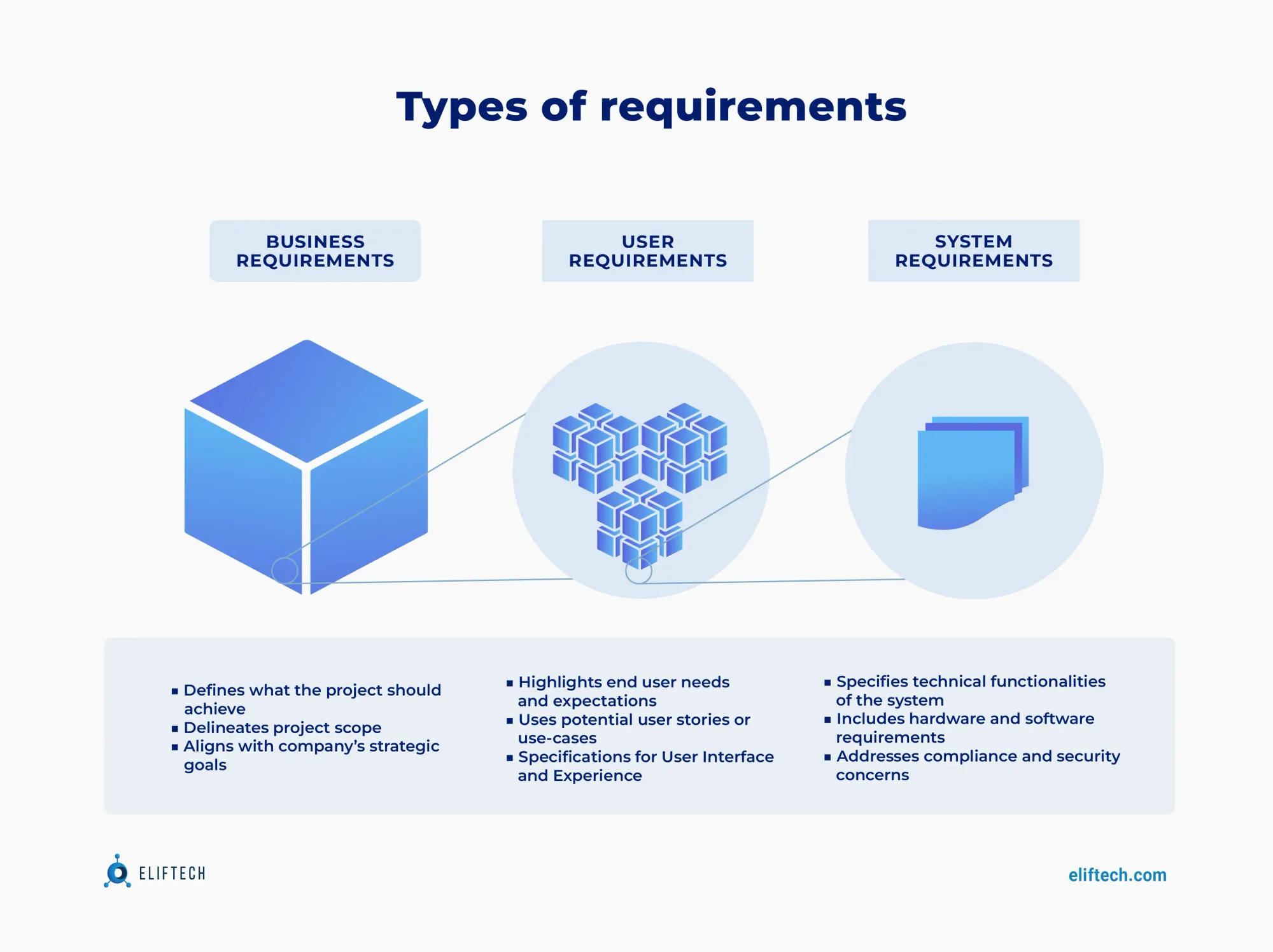Outsourcing
10 Software Development Best Practices to Follow in 2024

As we stand on the cusp of 2024, it's vividly clear that the software development domain is facing an overhaul. The discourse around software development, traditionally revolving around frameworks, methodologies, and languages, now incorporates a new, influential aspect. Technologies once classified as 'emerging' – like Artificial Intelligence, Machine Learning and Blockchain – have begun to shift the tides. While it's exciting, it puts into perspective the need to reshape our best practices, to keep pace, and more so, to innovate.
This article serves as a lens providing a focused view into what the future might look like. We'll go beyond simply listing software development best practices for 2024. We aim to analyze the whys and hows of their evolution, driven by the transformative impact of new technologies, and offer actionable insights to facilitate your adaptive journey. Because the real deal isn't just in knowing the change is happening: it's in analyzing, understanding, and expertly navigating it.
Software development best practices: What’s new in 2024?
In the world of software development, one thing remains constant: change. Over time, we've seen our methodologies and technologies evolve to meet changing demands and expectations.
From monolithic systems of yesteryear, we've moved to microservices. We've bid farewell to waterfall models, adopting instead Agile and DevOps. These transitions have made software development more adaptable and responsive, catering to the expectation for quicker delivery and smoother user experiences.
Talking of user experience, it has also seen a shift – today's users value intuitive, easy-to-use interfaces and smooth interactions, alongside the expected functional robustness. Hence, practices have now incorporated dedicated UX design and testing phases, often prioritizing these user-centric aspects.
The rise of Machine Learning, AI development, and Blockchain also signals an imminent shift. For instance, AI has introduced new levels of efficiency in bug detection. With ML, software can 'learn' from user behavior data, identify patterns and preferences, which can then be used to deliver a more personalized and intuitive user experience. And Blockchain is empowering enhanced security and transparency in the form of decentralized applications.
All these changes underline that the best practices in software development are not static; they morph with technological advances. They are akin to a versatile canvas, constantly being repainted with best practices that reflect new norms, yet retain the wisdom of older ones.

Sticking to the evolving best practices is vital and offers several benefits:
- Consistency in quality and performance – for instance, using standardized code reviews and automated testing practices, teams can catch any potential bugs or performance issues early and rectify them before deployment.
- Enhanced code maintainability – not only do clean, well-commented, and modular coding practices make it easier to understand and modify the code, but they also simplify the integration of new features.
- Improved security – security best practices, such as regular code audits and embracing security-focused development philosophies like DevSecOps, can harden the software against potential breaches.
- Faster, more efficient development cycles – with the use of Agile methodology, developers work in shorter sprints, allowing for faster feedback loops and more efficient updates.
- Superior user experiences – adopting a user-centric design approach, developers ensure the software serves intuitive and responsive interfaces.
Software development best practices to follow
Adherence to agile software development best practices isn't simply a recommendation; it is an absolute necessity. Ignoring these established guidelines could result in more than just increased investment and extended timelines – it could also spell a journey toward poor end results. Statistics suggest that inefficient process management can potentially hike software production times by as much as 30%, leading to corresponding cost escalations.
However, not all is lost. Viewing the situation through a more optimistic lens, and integrating these best practices into daily routines carries substantial benefits. It’s an investment in the quality, reliability, and overall success of your projects.
Moving forward, we'll delve into these practices, study their impact, and guide you through their practical implementation, highlighting how evolving technologies can enhance their effectiveness.
Clarity in requirement gathering
Think of a construction company being asked to construct a skyscraper without blueprints – impossible, right? In the same vein, requirements give developers the blueprints for software construction. In fact, 50% of all defects in a project can be traced back to incorrect, incomplete, or unclear requirements. It risks inflating costs due to constant reworks and elongating timelines from endless revisions. Even scarier, you could end up with a product that is worlds away from what stakeholders had envisioned or that doesn't fit the market. The fallout isn't just financial – losing client trust could be a steep price to pay. Ultimately, neglecting this pivotal step can derail your project, causing more harm than good.

Gain clarity in requirement gathering to make your software efficient and market-fit with expert product discovery services.
How to implement:
- Engage thoroughly and frequently with all stakeholders. Clear communication is paramount in this phase. Understand their needs, note down their expectations, and always validate your understanding.
- Document everything. Be it the most insignificant detail or a giant game-changer, put it down on paper. Efficient tracking tools can be a valuable aid.
- Ask the right questions. During stakeholder communication, focus on not just what they want but why they need it. This aids in understanding the underlying business needs.
- Work in terms of user stories or use cases. This can help envisage how a user will interact with the system, providing valuable context that can inform requirement development.
- Involve developers early. Developers can provide valuable input on what is feasible or complicated, reducing misconceived expectations. Having their insights early can help to better manage technical and non-technical stakeholder expectations.
- Validate requirements frequently. Regular check-ins with clients and stakeholders help ensure the development is on the right track.
- Conduct usability testing. When possible, conduct usability testing with prototypes to gain valuable insights about the product from an end-user's perspective and refine the requirements accordingly.
- Manage changes effectively: Expect change and establish a change control process. This way, when business needs shift, you can systematically assess and integrate changes into the development process without causing unreasonable delays or confusion.
- And, of course, prioritize. Determine the importance and order of the requirements based on their value addition to the end product. This filtering process helps the team focus on what matters most to stakeholders.
Adhering to a systematic development process
A systematic development approach is key in software creation. Notably, in 2023, 71% of organizations turned to Agile, and 83% opted for DevOps. These methodologies, known for their structured processes, have shaped the development industry, continually proving their effectiveness. Both of them significantly increased responsiveness to changing requirements, fostering a culture of continuous improvement and collaboration.
Discover how DevOps as a Service can improve your software's efficiency.
How to implement:
- Select Agile, Lean, or another systematic methodology that best aligns with your team's capabilities and project goals.
- Embrace a culture of collaboration. Agile and DevOps foster closer collaboration between different roles. Communication is key in these methodologies, so regular meetings like daily stand-ups in Agile help keep everyone on the same page.
- Ensure your team is well-trained in, the chosen methodology and understands the stages and principles involved.
- Use appropriate tools. From tracking progress in Agile sprints to facilitating continuous integration/continuous delivery (CI/CD) in DevOps, select tools that suit your specific needs.
- Continually look for improvements and refinements to the current process. Follow a "build-measure-learn" feedback loop.
- Consider adding features such as intelligent automation, predictive analytics, and AI-enhanced testing where applicable.
- If you are new to Agile or DevOps, consider starting with a pilot project.
Utilizing application frameworks
“Don’t reinvent the wheel.” That common wisdom pretty much sums up the main reason for utilizing application frameworks. These ready-made structures come packed with reusable code that can speed up development while reducing potential coding errors and security loopholes. Ignoring these frameworks is like facing a challenge and realizing a solution already exists – you just didn't utilize it; that's the risk here.
Following this practice, you may save hours not having to write redundant code; plus, you'll get a consistent structure across your applications. You'll spend less time on 'plumbing' and more on customizing the core features that make your app unique.
How to implement:
- Evaluate your project goals, tech stack, and team skills. This should guide your choice. Understand the functionalities and features you need from the framework.
- Dig into some popular frameworks that align with your tech stack. Look into their strengths, weaknesses, community support, and documentation.
- Run a small pilot project or proof of concept with your chosen framework. This can reveal potential issues and confirm if it's the right fit for your team.
- Frameworks usually enforce a certain coding standard or style. Ensure all team members adhere to this to maintain code consistency and readability.
- Once you've picked your framework, ensure your team is sufficiently trained to use it effectively. Then, integrate it into your development process.
Ensuring code clarity and simplicity
Here's the thing – complex and obfuscated code is similar to bad handwriting. It's there, it works, but it's just a hassle for everyone dealing with it. Complexity breeds confusion, elevates error potential, and becomes a high-maintenance aspect fast. It tends to undermine productivity, bog down the troubleshooting process, and negatively influences overall efficiency.
Thus, the art of crafting code that embodies clarity is a fundamental practice. This isn't merely about creating a program that works – it's about setting the backbone for a development journey that is smooth, efficient, and lends itself to effortless understanding.
How to implement:
- Adhere to language conventions for consistent, understandable code. If you're coding in Python, follow the PEP 8 style guide. Maintain consistency in your syntax, indentation, and naming schemes.
- Instead of using complex structures or algorithms, opt for straightforward and efficient solutions whenever possible to reduce errors and maintain clean code.
- Use clear, meaningful names for variables, functions, and classes to enhance readability – instead of using "x" or "data", use descriptive names like "employee_age" or "product_price".
- Conduct regular code reviews to spot potential issues and keep code efficient.
- Include useful comments to provide context and clarify complex code sections.
Regular code reviews
The practice of regular code reviews is about maintaining a consistent standard of quality and efficiency in your codebase. This isn't merely a one-time or arbitrary process – it's about implementing an essential checkpoint that allows for early detection of potential issues, elimination of unnecessary complexities, and the assurance of optimal code performance.
Code without regular reviews is like a car that never receives servicing or routine checks. It might run for a while, but eventually, unseen issues could pile up, leading to a sudden breakdown. Regular code reviews prevent these hiccups, ensuring the code stays in tune and runs smoothly. They assist in making the troubleshooting process more manageable, improving productivity, optimizing efficiency, and eliminating code debt before it escalates.
How to implement:
- Leverage built-in functionalities of platforms like GitHub, GitLab, or Bitbucket for code reviews via pull or merge requests.
- Formulate standard procedures for conducting coding reviews to maintain consistency. These procedures can include checking naming conventions, requiring unit tests, and comprehensive documentation.
- Integrate automated testing. Use tools that provide automated code tests, such as lintels, to catch common coding mistakes and style errors before proceeding with manual code reviews.
- Ensure relevant individuals, based on their expertise or familiarity with sections of the code, are included in the reviewing process.
- Foster an environment where code reviews focus on improving the quality and efficiency of the codebase, with positivity and constructive criticism at its core.
- Incorporate regular code reviews into the development routine to ensure continuous quality and maintainability of the codebase.
Automated testing
Automated testing is a key aspect of modern software development practices. It enables developers to validate the correctness of their code without manual intervention. The main aim of automated testing is to make the testing process more efficient, reliable, and repeatable.
Regular automated testing leads to improved software quality by detecting bugs and issues early before they escalate and influence the overall system functionality. It also speeds up the development process, as testing is undertaken quickly and routinely, making the code reliable and deployment-ready at a faster pace.
How to implement:
- Choose from a range of testing tools such as JUnit, PyTest, or Jest that match your requirements.
- Prioritize the key sections of your application that need rigorous testing.
- When writing code, consider how easily it can be tested and validated.
- Consistently review and update your tests to match code modifications and maintain testing accuracy.
Continuous Integration
Continuous Integration (CI) is a development practice where developers regularly merge their code changes into a shared repository. After the merge, automated builds and tests are carried out to catch bugs or issues promptly.
CI promotes more frequent code integrations, minimizing the time and effort needed to eliminate bugs. It reduces integration problems, allowing development teams to deliver software more rapidly. Moreover, CI makes the early stages of software delivery faster and safer by promptly catching and addressing issues.
How to implement:
- Choose a CI tool that fits your project needs, like Jenkins, CircleCI, or Travis CI.
- Set up automated builds to compile and validate your code after each integration.
- Write automated tests to ensure each integration meets the expected behavior.
- Maintain a shared repository where changes can be integrated regularly.
- Encourage the team to integrate their changes frequently, ideally multiple times a day.
- Ensure failing builds are corrected at the earliest to maintain a stable codebase.
Version Control Systems
Version Control Systems (VCS) are tools that help manage changes to source code over time. They keep track of every modification to the code in a special kind of database. If a mistake is made, developers can turn back the clock and compare earlier versions of the code to help fix the mistake and minimize disruption to all team members.
VCS allows multiple people to simultaneously work on a single project. Each person edits his or her own copy of the files and chooses when to share those changes with the rest of the team. Therefore, VCS maximizes team collaboration, reduces code conflicts, and aids in maintaining a clean, historical record of code changes.
How to implement:
- Select an appropriate VCS: Git is, of course, the most widely used one, but other options like SVN or Mercurial are also available.
- Maintain a centralized repository where all code changes will be stored.
- Encourage the team to regularly commit and sync their changes with the central repository.
- Use branching for separate features or stages of your project. This keeps changes organized and isolates them until they're ready.
- Do regular merges of branches to bring them up to date and ensure they don't diverge too far from the main line of development.
Avoid over-engineering
Avoiding over-engineering is one of the key strategies of software development best practices. Over-engineering refers to the addition of more features than necessary, which could make the software more complicated and difficult to use. Moreover, it can lead to wastage of resources including time and money.
How to implement:
- Focus on core features. Determine the minimum set of features that deliver value to users and focus on implementing them exceptionally well.
- Embrace simplicity. The easiest solution is often the best. Prioritize writing simple, readable code over complex or clever solutions.
- Use an iterative approach. Build the basic functionality first and then gradually add enhancements based on user feedback. This allows for the aligning of software features with the real needs of users.
- Learn to say no. Not every feature request needs to be implemented. Often, the key to effective software is knowing what to leave out. Prioritize user needs and business objectives over adding features.
- Conduct regular code reviews. Code reviews often help in identifying and eliminating unnecessary complexity.
Investing in continuous learning
We've all heard about the wave of layoffs affecting tech employees in recent times. According to Layoffs.fyi, sizable layoffs impacted over 250,000 tech employees across 1,100+ companies in the past year. However, software engineering and quality assurance skills continue to be highly sought after. For example, a single tech company reported 27,410 layoffs but simultaneously had 5,437 developer roles open as of mid-November.
This trend underscores the shift in the tech industry towards continuous learning. Investing in continuous learning keeps your team up-to-date with industry trends, new technologies, and best practices. Doing so can improve project outcomes, increase efficiency, and foster innovation. Additionally, continuous learning aids in employee retention by providing career growth opportunities that improve satisfaction and loyalty.
Progressive software development vendors, particularly in the realm of team extension, are adopting and implementing best practices for continuous learning to achieve these benefits.
How to implement:
- Set up regular training sessions, workshops, or "lunch and learn" events. You could also encourage peer-to-peer learning and mentoring.
- Foster an atmosphere that promotes independent learning. Allot some work hours for self-study so employees can deepen their knowledge in their areas of interest.
- Regularly track skills growth and knowledge enhancement to assess the effectiveness of the provided learning opportunities. Adjust strategies based on feedback.
- Allow some flexible work hours that employees can devote to learning. This could be "innovation time", study leaves, or simply allowing a few hours each week for personal development.
Leveraging emerging technologies in software development
In a landscape where cutting-edge solutions and novel technological trends are sprouting at an astonishing pace, they hold compelling implications for the way we design, develop, and deploy software.
- As of 2023, a GitHub survey states that 92% of U.S.-based developers are using AI-driven coding tools for personal and professional tasks, demonstrating the rise of AI in shaping software development practices.
- Furthermore, 88% of developers reported using CI/CD practices generally in the software development process.
These statistics and trends underscore the substantial influence that emerging technologies hold in reforming software development methods, making them a vital part of the modern software ecosystem. Here's a look at some notable cases that are showing how technologies are changing the process:
Implementing AI in bug detection
One of the most promising trends on the horizon is the use of artificial intelligence (AI) and machine learning (ML) in software development. One common example is their application in bug detection and code reviews.
Traditional methods of bug detection were tedious and time-consuming for developers. With the advent of AI, developers can now utilize intelligent automation tools. These tools, underpinned by Machine Learning algorithms, effectively spot and rectify bugs. This revolution not only speeds up bug detection but enhances accuracy too – freeing developers to do what they love: code and create.
Facebook already developed and uses an AI-powered tool named SapFix that automatically generates fixes for bugs and submits them to engineers for approval. As of 2018, SapFix was capable of generating patches for production-level software and was actively tested internally at Facebook.
DeepCode is another platform that uses AI for code reviews. Trained on an extensive code database, DeepCode can identify bugs, vulnerabilities, and critical code quality issues by analyzing a codebase.
Using AI for predicting development delays
AI creates opportunities for the predictive dimension in project management as well. By leveraging historical project data, AI can learn and identify patterns that could lead to schedule overruns or bottlenecks in software pipelines. This predictive capability allows project managers and development teams to take proactive steps to mitigate risks and prevent delays.
An excellent instance of this technology implementation is Atlassian's team which introduced next-gen project templates with ML-driven insights. These insights help the team predict development time, reduce context switching, and streamline the overall software development cycle.
Embracing cloud technologies
Harnessing the power of cloud technologies has become a pivotal aspect of contemporary software development practices. This is not exactly a “nascent” trend, it’s been here for a while, but it’s in recent times that its adoption has truly been a game-changer with platforms such as AWS, Google Cloud, and Microsoft Azure leading the way.
One of the pivotal advantages of employing cloud technologies is the ability to rapidly prototype. Developers can quickly build and test ideas in a cloud environment, thus significantly cutting down the traditional cycle of development.
Besides, the cloud provides unparalleled scalability. Projects can now start small and grow exponentially without worrying about infrastructure limitations. Any increase in demand can be accommodated by simply scaling up the cloud resources, providing immense flexibility.
A practical implication of cloud technology can be seen with Netflix. They utilize a cloud-based notebook platform that allows their data scientists to create, execute, and share their codes effortlessly among their team. The platform enables live collaboration, promotes code sharing, and reduces redundancy, thereby improving overall productivity.
Conclusion
A myriad of strategies, methodologies, frameworks, and languages shape our work. Yet underlying these, there exists a compelling driving force – technology. Technology, with its relentless pace of innovation, profoundly influences not just our everyday lives; it continues to redefine the contours of the software industry.
However, harnessing these practices and technologies' potential is not a trivial endeavor. It calls for an inclination towards continual learning, a willingness to adapt, and the expertise to incorporate new trends without disrupting the existing workflow.
As software development professionals, we steadfastly uphold a balanced approach that integrates best practices for software development with the latest advancements in technology. We recognize the revolutionary changes that AI, IoT, and other emerging technologies are triggering in the software industry. Our approach involves continuous learning, leveraging these dynamic technologies to deliver robust, scalable, and innovative solutions, whether you require custom web and mobile application development, QA and testing, or DevOps as a service. We offer services in FinTech, e-commerce, healthcare, and wealth management, among others, to meet your diverse needs.
Interested in learning more about how we blend best practices with advanced tech? Let’s talk, we'd be delighted to share more about our approach.
